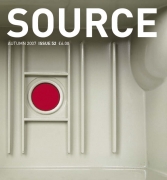Wrapped in Countryside
Donovan Wylie: British Watchtowers - Belfast Exposed 25th May - 3rd August 2007
Review by Colin Darke
Issue 52 Autumn 2007
View Contents ▸
Art in the north of Ireland has tended to engage with its conflict from a few steps behind, gazing on it from a safe distance. There are a few exceptions to this rule, but it seems there has been an effort, conscious or otherwise, to establish a temporal gap between our shared experience of the troubles and our engagement with them through the arts. This may have arisen through fear of association with a political environment which demands side-taking or merely a reflection of the general separation of art and politics over the past couple of decades or so. Either way, art which addresses the conflict has done so, on the whole, in retrospect. Now that the fighting has stopped, then, one can assume it will be fair game for plenty of ex post facto scrutiny.
Since it became clear that the apparent identity of the British Army watchtower was to change from oppressive reality to historical memory, it has become an acceptable and popular subject for the artist. Just as the romantic landscape painter may gain pleasure from the long-defunct medieval military fortification or the head of a summer parade can carry an antique lethal weapon under the title of ceremonial sword, the redundancy of this strategic tool of the state makes it tolerable subject matter.
Magnum photographer Donovan Wylie has followed his 2002/2003 visual obituary of Long Kesh with this series of aerial photographs of since-demolished watchtowers. Just as with The Maze, depicting the abandoned gaol, a museum of itself where the existence of time and its own history seem to have been erased, leaving for the viewer an existential wilderness to contemplate, Wylie, in this new series, archives the redundant architecture of war with a visual pleasantness which conceals the nastiness of its role. The detritus of the north's recent history of death, torture and brutalisation has apparently become the stuff of romantic landscape, the artist's concealment of its reality sanctioned and assisted by the violent state apparatus which operated there. Romeo 21 Tower A, N/E - Courtesy Belfast Exposed
Romeo 21 Tower A, N/E - Courtesy Belfast Exposed
From an Army helicopter, he has created images of the complexes, some in residential areas, most in stunningly beautiful rural settings, dwarfing them in such a way that their purpose is concealed. They bring to mind the H-Block paintings of Rita Donagh (which were made while the cells were occupied), referring in themselves to the sixteenth-century Flemish painting of the Battle of Pavia. The distance and overhead viewpoint in Donagh's pieces, as in Wylie's photographs, alienate us from the function of the subject, but in the former we are made to question this estrangement, forcing us to consider the unseen reality, while in the latter such Brechtian consideration is denied us. The towers become benign and even their blot-on-the-landscape status is denied.
This alienation is highlighted by the striking absence of people. Only two pieces contain any signs of life. With the exception of one, which contains two people with their backs to us, Wylie has remarkably managed to capture the residential areas with the emptiness of ghost towns. In one of the rural images, a British soldier stands, hands on hips, staring up at us. In the context of the surrounding, empty, photographs in the show, this produces the same kind of double-take we've been experiencing in recent years on the rare occasions we've seen Brits on the streets.
Why this lack of people? The removal of the watchtowers' surveillance role is complete devices for watching, with no one to look at. They have been reduced to incongruous architectural follies with no visible sense of intimidation beyond their physical ugliness.
The countryside watchtowers, despite relying more on pylons for their observation than the manned towers familiar to urbanites, are constructed from the same green corrugated steel and they are surrounded by matching boxes, what I take to be living quarters, similar to portakabins, but windowless and more like shipping containers.
This is where comparison with the ancient fortification breaks down. The passage of time changes significance and perception, allowing a hill fort to become an object of historical interest and a thing of beauty. A seventeenth-century cannon, removed from its time and its murderous task, can perform as a tourist attraction in a way denied a contemporary rocket launcher which still acts as a personal reminder of events which took place in living memory. History transforms the signification of all things; the watchtower will for some time remain a part of our political reality.
Ugly the towers may be, but Wylie wraps them in their surrounding countryside very well indeed. Like half-opened unwanted gifts they sit uncomfortably in their gorgeous environment. Of course, these are views of familiar terrain made unfamiliar by their aerial origins. Belfast Exposed Exhibitions Director Karen Downey, describing the photographs, points out that they afford us 'the privileged, panoramic views once enjoyed only from the watchtowers' (and, as in this case, from military aircraft). This creates a strange paradox as our joy at the spectacle of a unique experience of beautiful vistas is placed in opposition to what is, for most of us anyway, a reason to be rather less than cheerful.
But there's no critique to be seen here, no dialectic activated by the contradictions, not even any sense of irony. These are beautified archival records of places of huge historical significance, with the history taken away, of objects which contributed to the state oppression of communities, but with no people to be seen. They thus say nothing of any importance to anyone, except perhaps to the previous inhabitants of the watchtowers they depict.
Other articles by Colin Darke:
Other articles on photography from the 'Security' category ▸






